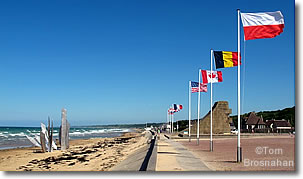|
|
|
Operation Overlord, the largest amphibious military invasion in history, began just after midnight on June 6, 1944 when 24,000 American, British, Canadian and Free French airborne troops in gliders and with parachutes, landed behind the German lines along the coast of Normandy. The date was chosen because it featured both a full moon to light the way for the airborne troops, and a spring high tide at daybreak to carry the landing craft as close as possible to the beach. The weather on the date was much less than ideal, but the decision was made to take the chance as the next possible invasion date was almost a month later. The poor weather and clouds limited the Allied air forces from reducing as much of the German defense as they had hoped, which would make the troop landings more difficult; but the bad weather also lulled the German defenders into thinking the Allies would not invade under suboptimal conditions. At 06:30 am (GMT+2), Operation Neptune commenced with the landing of 160,000 Allied infantry troops, tanks, guns and thousands of tons of supplies from more than 5000 ships along an 80-km (50-mile) stretch of Normandy beach to face Hitler's Atlantic Wall defences. Each section of beach had a code name and troops assigned to it. From east to west they were: Sword and Gold (UK), Juno (UK & Canadian), Utah and Omaha (USA). Heavily-fortified Omaha Beach and the steep Pointe du Hoc promontory proved to be the most difficult invasion points, with the greatest numbers of casualties and losses of matériel, but by the end of the day the Allied troops had a tenuous hold on the beach and some were proceeding inland. By D-Day+3 the beachhead was fully secured and most of the original D-day objectives inland had been gained. An artificial port had been built at Arromanches on Gold Beach to bring in the thousands of tons of food, medical supplies, equipment, ammunition and armaments necessary to supply the huge army, and PLUTO (Pipe Line Under The Ocean) was bringing millions of gallons of motor fuel from England. By June 30, 1944, the Allies had established a well-defended and -supplied presence all along the Normandy coast. However Caen, with its crucial network of roads, railroads and river port, was vigorously defended (including by many crack German Panzer tank units), and did not fall completely until July 21, by which time it was mostly in ruins. Still, during the battle for Caen, Allied forces were pushing along the Seine toward Paris, which they reached on August 19, 1944, 2-1/2 months after D-Day.
|
|
|


